2010 LINCOLN TOWN CAR ignition
[x] Cancel search: ignitionPage 258 of 285
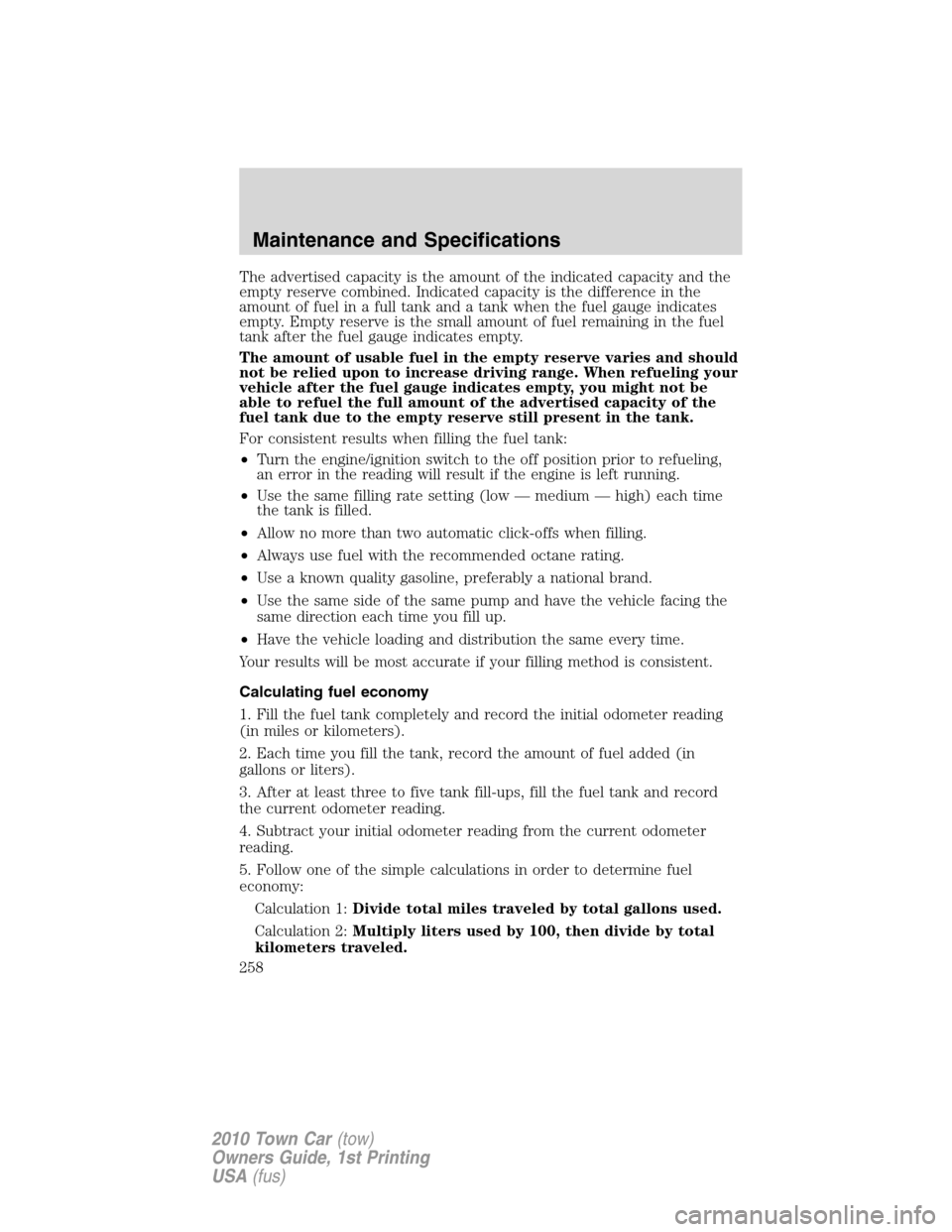
The advertised capacity is the amount of the indicated capacity and the
empty reserve combined. Indicated capacity is the difference in the
amount of fuel in a full tank and a tank when the fuel gauge indicates
empty. Empty reserve is the small amount of fuel remaining in the fuel
tank after the fuel gauge indicates empty.
The amount of usable fuel in the empty reserve varies and should
not be relied upon to increase driving range. When refueling your
vehicle after the fuel gauge indicates empty, you might not be
able to refuel the full amount of the advertised capacity of the
fuel tank due to the empty reserve still present in the tank.
For consistent results when filling the fuel tank:
•Turn the engine/ignition switch to the off position prior to refueling,
an error in the reading will result if the engine is left running.
•Use the same filling rate setting (low — medium — high) each time
the tank is filled.
•Allow no more than two automatic click-offs when filling.
•Always use fuel with the recommended octane rating.
•Use a known quality gasoline, preferably a national brand.
•Use the same side of the same pump and have the vehicle facing the
same direction each time you fill up.
•Have the vehicle loading and distribution the same every time.
Your results will be most accurate if your filling method is consistent.
Calculating fuel economy
1. Fill the fuel tank completely and record the initial odometer reading
(in miles or kilometers).
2. Each time you fill the tank, record the amount of fuel added (in
gallons or liters).
3. After at least three to five tank fill-ups, fill the fuel tank and record
the current odometer reading.
4. Subtract your initial odometer reading from the current odometer
reading.
5. Follow one of the simple calculations in order to determine fuel
economy:
Calculation 1:Divide total miles traveled by total gallons used.
Calculation 2:Multiply liters used by 100, then divide by total
kilometers traveled.
Maintenance and Specifications
258
2010 Town Car(tow)
Owners Guide, 1st Printing
USA(fus)
Page 260 of 285
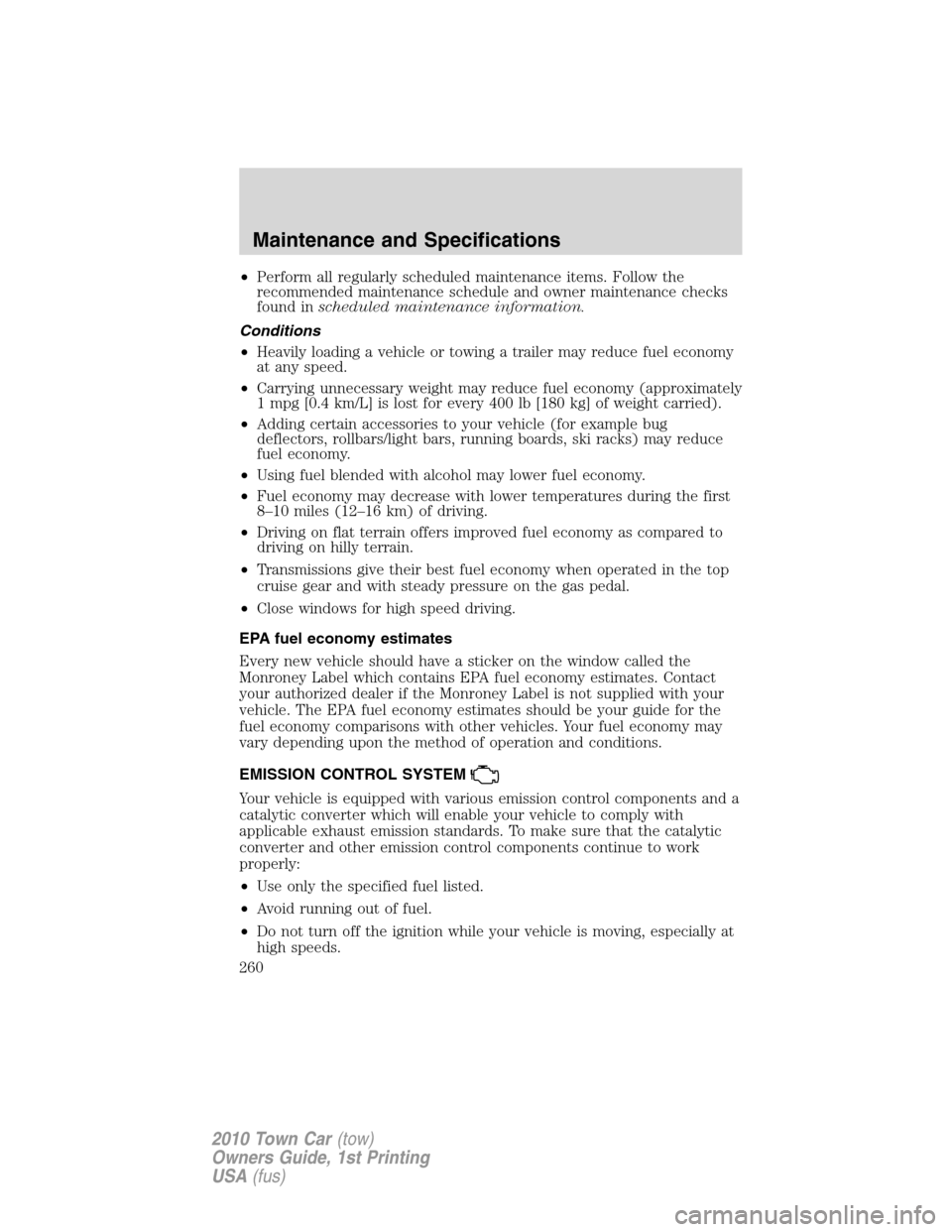
•Perform all regularly scheduled maintenance items. Follow the
recommended maintenance schedule and owner maintenance checks
found inscheduled maintenance information.
Conditions
•Heavily loading a vehicle or towing a trailer may reduce fuel economy
at any speed.
•Carrying unnecessary weight may reduce fuel economy (approximately
1 mpg [0.4 km/L] is lost for every 400 lb [180 kg] of weight carried).
•Adding certain accessories to your vehicle (for example bug
deflectors, rollbars/light bars, running boards, ski racks) may reduce
fuel economy.
•Using fuel blended with alcohol may lower fuel economy.
•Fuel economy may decrease with lower temperatures during the first
8–10 miles (12–16 km) of driving.
•Driving on flat terrain offers improved fuel economy as compared to
driving on hilly terrain.
•Transmissions give their best fuel economy when operated in the top
cruise gear and with steady pressure on the gas pedal.
•Close windows for high speed driving.
EPA fuel economy estimates
Every new vehicle should have a sticker on the window called the
Monroney Label which contains EPA fuel economy estimates. Contact
your authorized dealer if the Monroney Label is not supplied with your
vehicle. The EPA fuel economy estimates should be your guide for the
fuel economy comparisons with other vehicles. Your fuel economy may
vary depending upon the method of operation and conditions.
EMISSION CONTROL SYSTEM
Your vehicle is equipped with various emission control components and a
catalytic converter which will enable your vehicle to comply with
applicable exhaust emission standards. To make sure that the catalytic
converter and other emission control components continue to work
properly:
•Use only the specified fuel listed.
•Avoid running out of fuel.
•Do not turn off the ignition while your vehicle is moving, especially at
high speeds.
Maintenance and Specifications
260
2010 Town Car(tow)
Owners Guide, 1st Printing
USA(fus)
Page 263 of 285
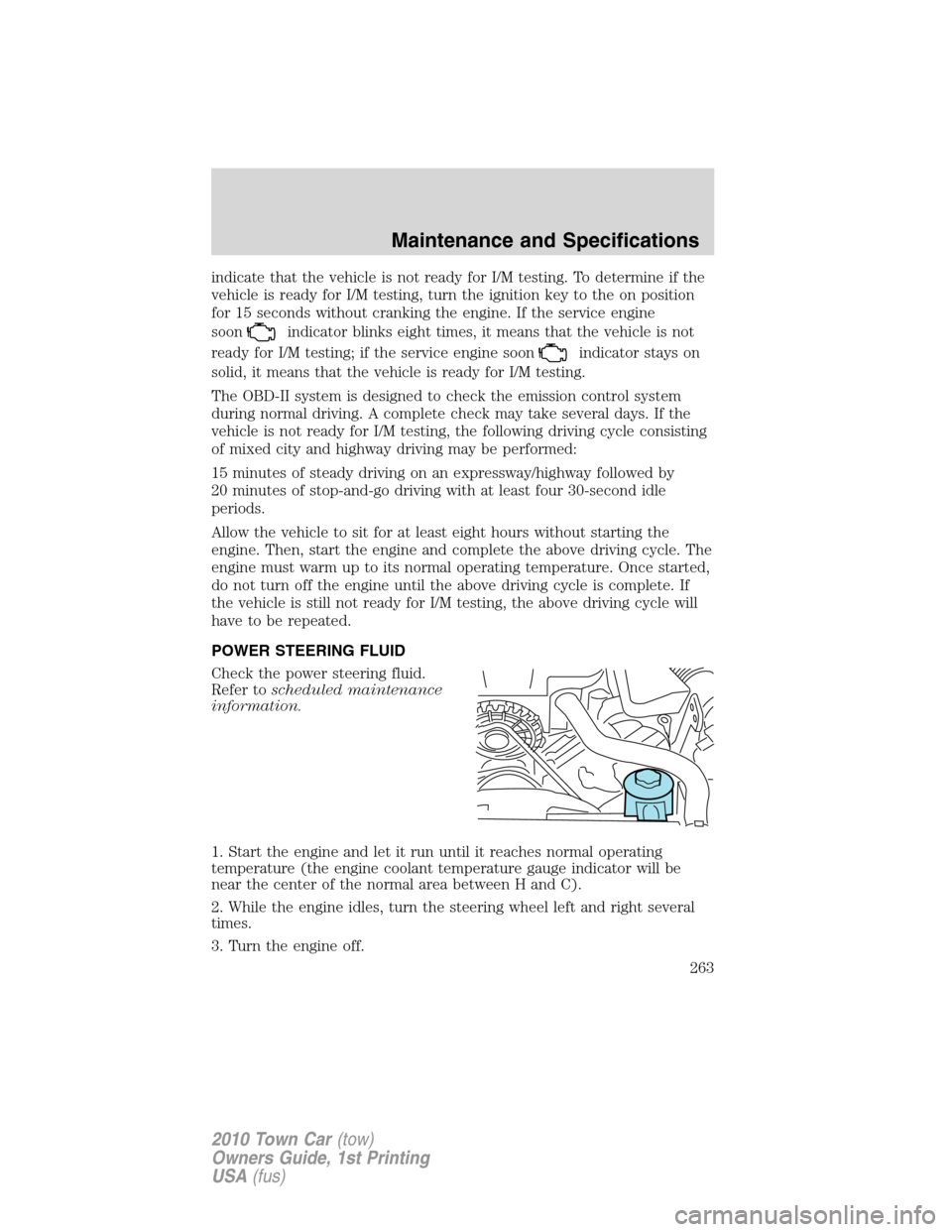
indicate that the vehicle is not ready for I/M testing. To determine if the
vehicle is ready for I/M testing, turn the ignition key to the on position
for 15 seconds without cranking the engine. If the service engine
soon
indicator blinks eight times, it means that the vehicle is not
ready for I/M testing; if the service engine soon
indicator stays on
solid, it means that the vehicle is ready for I/M testing.
The OBD-II system is designed to check the emission control system
during normal driving. A complete check may take several days. If the
vehicle is not ready for I/M testing, the following driving cycle consisting
of mixed city and highway driving may be performed:
15 minutes of steady driving on an expressway/highway followed by
20 minutes of stop-and-go driving with at least four 30-second idle
periods.
Allow the vehicle to sit for at least eight hours without starting the
engine. Then, start the engine and complete the above driving cycle. The
engine must warm up to its normal operating temperature. Once started,
do not turn off the engine until the above driving cycle is complete. If
the vehicle is still not ready for I/M testing, the above driving cycle will
have to be repeated.
POWER STEERING FLUID
Check the power steering fluid.
Refer toscheduled maintenance
information.
1. Start the engine and let it run until it reaches normal operating
temperature (the engine coolant temperature gauge indicator will be
near the center of the normal area between H and C).
2. While the engine idles, turn the steering wheel left and right several
times.
3. Turn the engine off.
Maintenance and Specifications
263
2010 Town Car(tow)
Owners Guide, 1st Printing
USA(fus)
Page 272 of 285
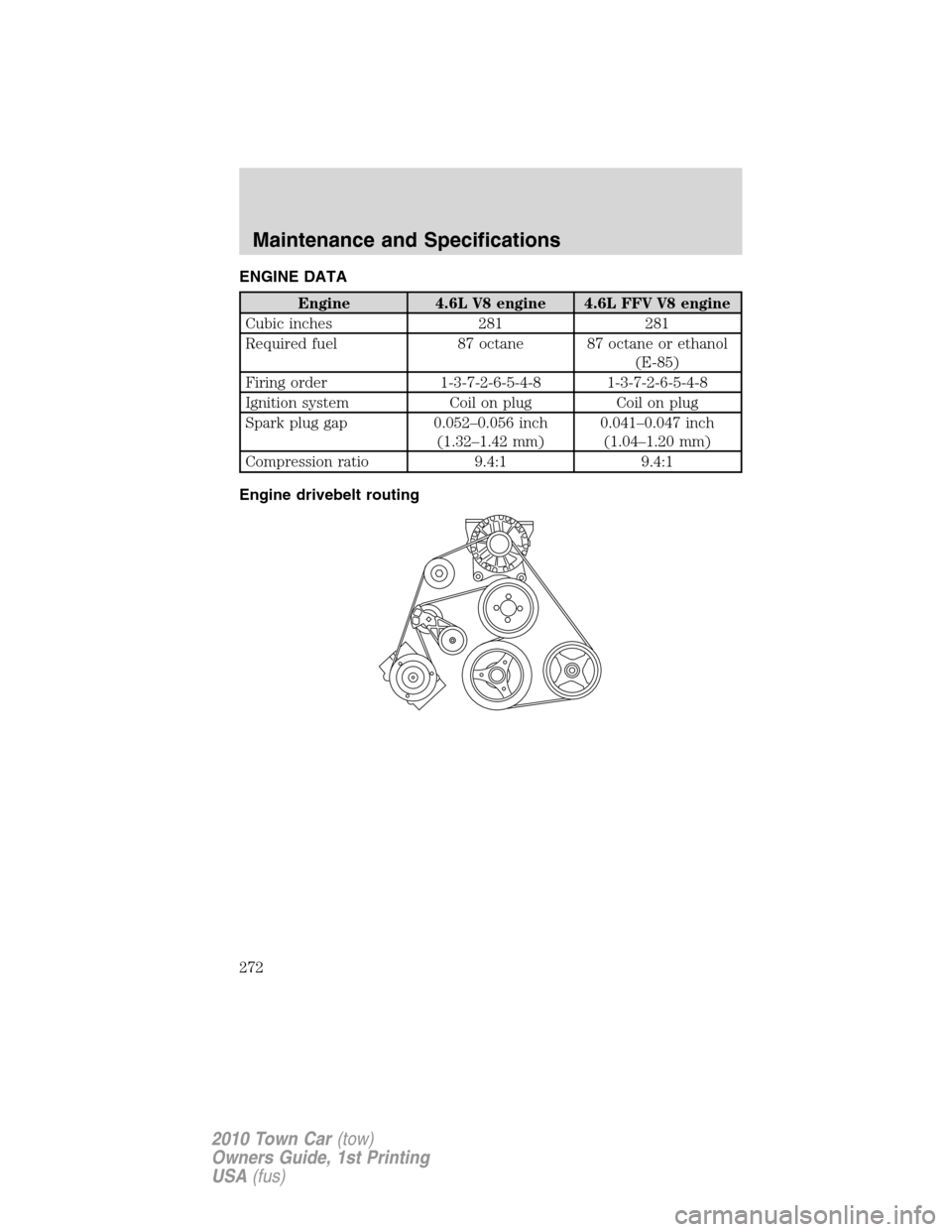
ENGINE DATA
Engine 4.6L V8 engine 4.6L FFV V8 engine
Cubic inches 281 281
Required fuel 87 octane 87 octane or ethanol
(E-85)
Firing order 1-3-7-2-6-5-4-8 1-3-7-2-6-5-4-8
Ignition system Coil on plug Coil on plug
Spark plug gap 0.052–0.056 inch
(1.32–1.42 mm)0.041–0.047 inch
(1.04–1.20 mm)
Compression ratio 9.4:1 9.4:1
Engine drivebelt routing
Maintenance and Specifications
272
2010 Town Car(tow)
Owners Guide, 1st Printing
USA(fus)
Page 282 of 285
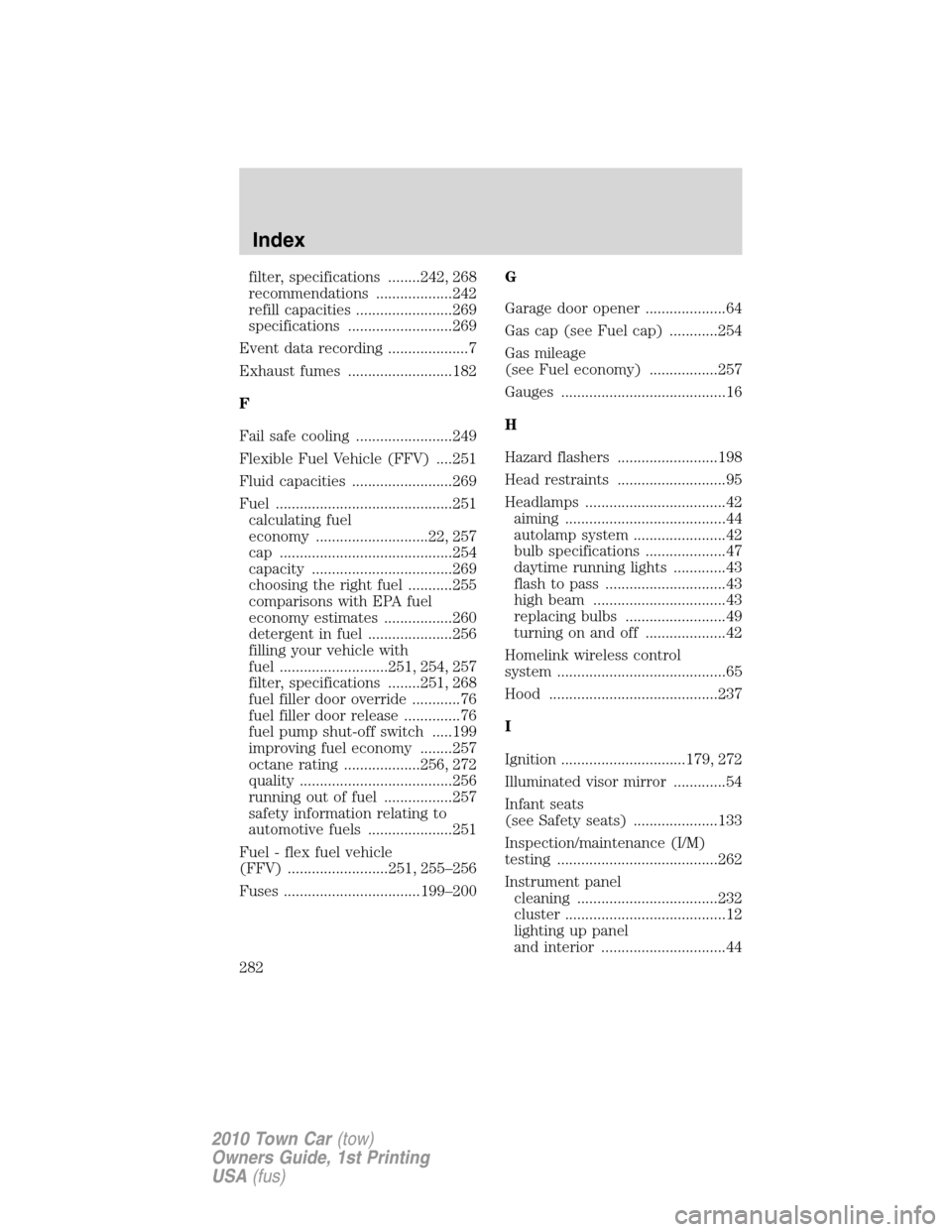
filter, specifications ........242, 268
recommendations ...................242
refill capacities ........................269
specifications ..........................269
Event data recording ....................7
Exhaust fumes ..........................182
F
Fail safe cooling ........................249
Flexible Fuel Vehicle (FFV) ....251
Fluid capacities .........................269
Fuel ............................................251
calculating fuel
economy ............................22, 257
cap ...........................................254
capacity ...................................269
choosing the right fuel ...........255
comparisons with EPA fuel
economy estimates .................260
detergent in fuel .....................256
filling your vehicle with
fuel ...........................251, 254, 257
filter, specifications ........251, 268
fuel filler door override ............76
fuel filler door release ..............76
fuel pump shut-off switch .....199
improving fuel economy ........257
octane rating ...................256, 272
quality ......................................256
running out of fuel .................257
safety information relating to
automotive fuels .....................251
Fuel - flex fuel vehicle
(FFV) .........................251, 255–256
Fuses ..................................199–200G
Garage door opener ....................64
Gas cap (see Fuel cap) ............254
Gas mileage
(see Fuel economy) .................257
Gauges .........................................16
H
Hazard flashers .........................198
Head restraints ...........................95
Headlamps ...................................42
aiming ........................................44
autolamp system .......................42
bulb specifications ....................47
daytime running lights .............43
flash to pass ..............................43
high beam .................................43
replacing bulbs .........................49
turning on and off ....................42
Homelink wireless control
system ..........................................65
Hood ..........................................237
I
Ignition ...............................179, 272
Illuminated visor mirror .............54
Infant seats
(see Safety seats) .....................133
Inspection/maintenance (I/M)
testing ........................................262
Instrument panel
cleaning ...................................232
cluster ........................................12
lighting up panel
and interior ...............................44
Index
282
2010 Town Car(tow)
Owners Guide, 1st Printing
USA(fus)
Page 283 of 285
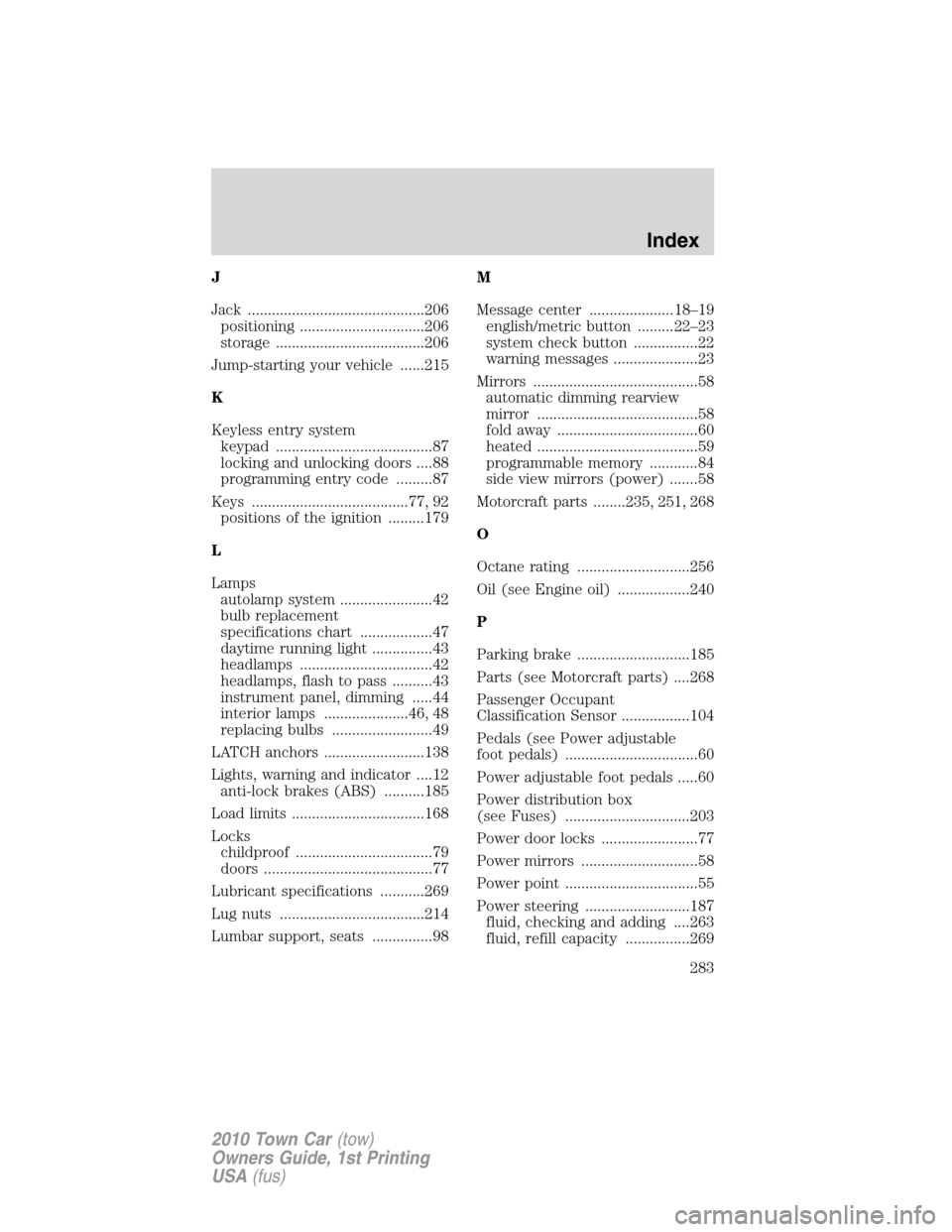
J
Jack ............................................206
positioning ...............................206
storage .....................................206
Jump-starting your vehicle ......215
K
Keyless entry system
keypad .......................................87
locking and unlocking doors ....88
programming entry code .........87
Keys .......................................77, 92
positions of the ignition .........179
L
Lamps
autolamp system .......................42
bulb replacement
specifications chart ..................47
daytime running light ...............43
headlamps .................................42
headlamps, flash to pass ..........43
instrument panel, dimming .....44
interior lamps .....................46, 48
replacing bulbs .........................49
LATCH anchors .........................138
Lights, warning and indicator ....12
anti-lock brakes (ABS) ..........185
Load limits .................................168
Locks
childproof ..................................79
doors ..........................................77
Lubricant specifications ...........269
Lug nuts ....................................214
Lumbar support, seats ...............98M
Message center .....................18–19
english/metric button .........22–23
system check button ................22
warning messages .....................23
Mirrors .........................................58
automatic dimming rearview
mirror ........................................58
fold away ...................................60
heated ........................................59
programmable memory ............84
side view mirrors (power) .......58
Motorcraft parts ........235, 251, 268
O
Octane rating ............................256
Oil (see Engine oil) ..................240
P
Parking brake ............................185
Parts (see Motorcraft parts) ....268
Passenger Occupant
Classification Sensor .................104
Pedals (see Power adjustable
foot pedals) .................................60
Power adjustable foot pedals .....60
Power distribution box
(see Fuses) ...............................203
Power door locks ........................77
Power mirrors .............................58
Power point .................................55
Power steering ..........................187
fluid, checking and adding ....263
fluid, refill capacity ................269
Index
283
2010 Town Car(tow)
Owners Guide, 1st Printing
USA(fus)